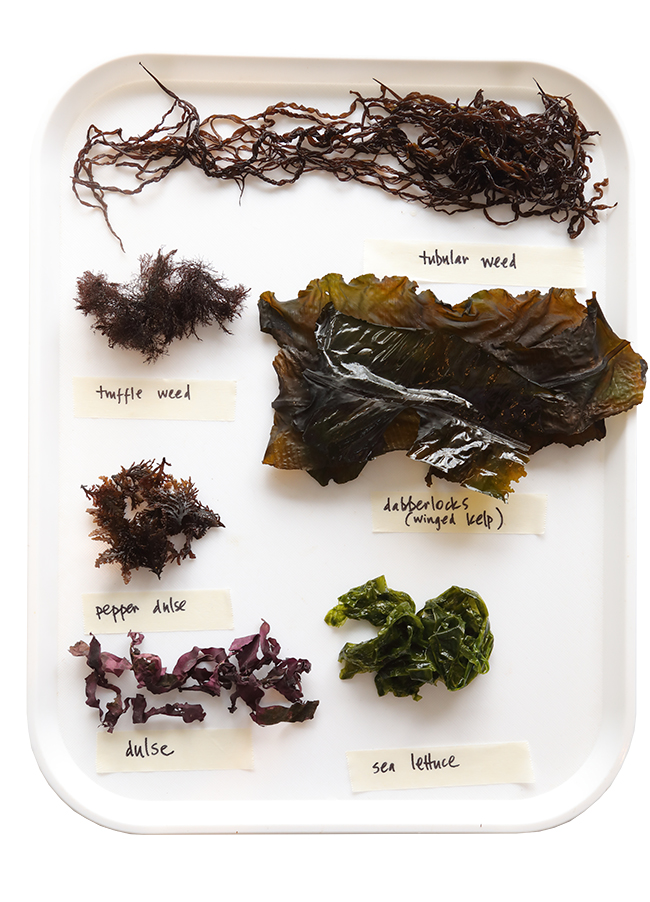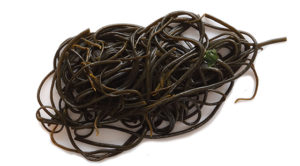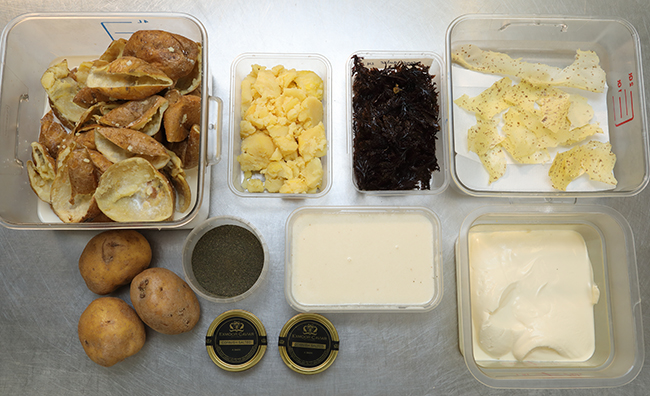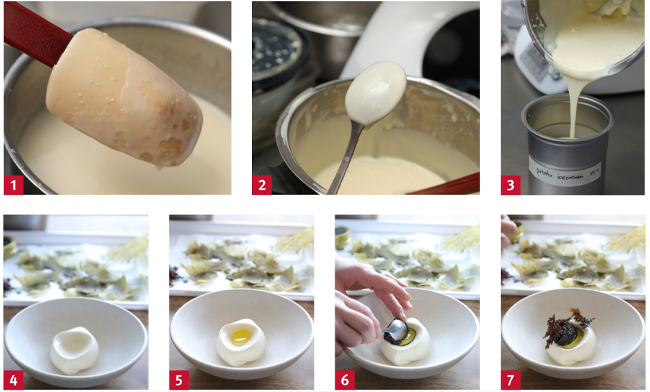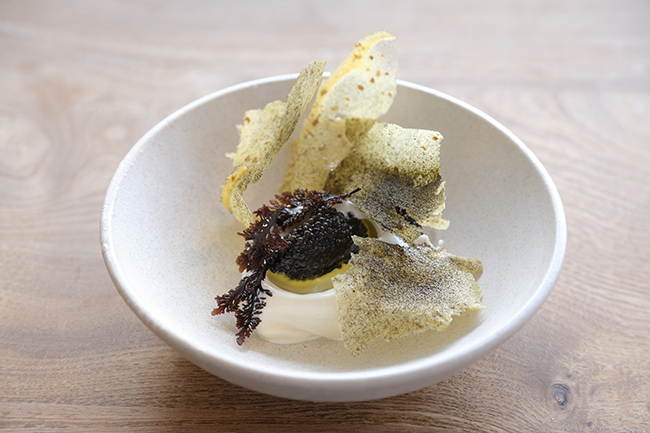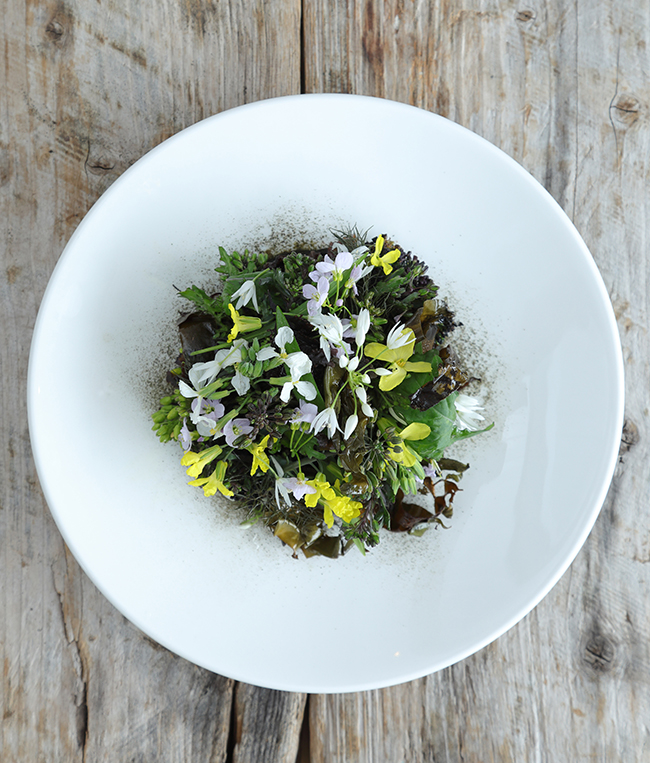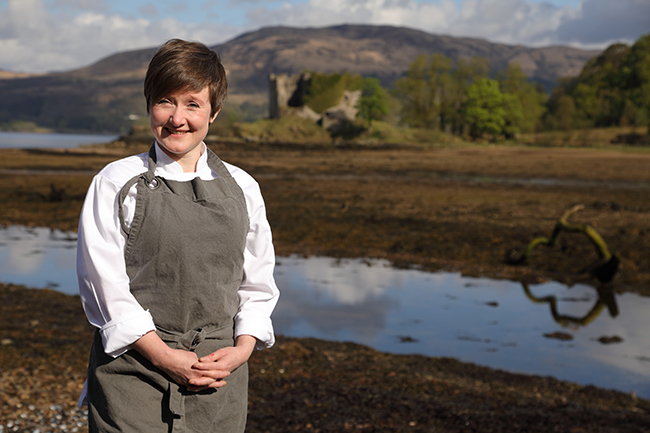A seaweed masterclass with Pam Brunton of Inver
Usually relegated to sushi wrappers, the uses for seaweed are as myriad as the available species. At Inver, near Loch Fyne in Scotland, chef Pam Brunton incorporates them in a variety of ways, and demonstrates two dishes to Michael Raffael
What most chefs know about edible seaweeds would fit on the back of a postcard. Everybody who has eaten sushi will have tasted nori, and kombu (kelp) is a basic ingredient of dashi, the Japanese broth. Porphyra, the reddish alga that turns green when cooked, features in Welsh laverbread, and food processors use carrageen and agar agar as stabilisers.
That's a tiny package of culinary boxes ticked compared to seaweed's overall potential as a vegetable. In fact, the authoritative Cambridge World History of Food lists more than 150 edible kinds. Japan has exported its sophisticated approach to working with seaweeds and a little of its knowledge has reached the West. The rest of the globe, from Mexico to Peru and China to Hawaii, also cooks, pickles or eats seaweeds raw, in ceviches, soups and salads and dished up with noodles. Almost all of this international repertoire remains a closed book, shrink-wrapped inside the countries of origin.
At Inver, on the shores of Loch Fyne on Scotland's west coast, chef Pam Brunton incorporates seasonal seaweeds growing on the shores into salads and cooked dishes at the restaurant, as well as using them as condiments. She treats every variety on its merits and none goes into a recipe willy-nilly.
Here, Duncan Smallman of Caledonian Seaweeds offers a run-down of some popular varieties, while overleaf Brunton shares two seaweed recipes.
A guide to Inver's seaweeds
Laminaria digitata
Similar to Japanese kombu and used in dashi. Fried until crisp, it has a kind of sweet cabbage flavour. It can be chewy with a definite, umami-rich edge.
Season November/December to June/July.
Dabberlocks/honey-ware/ Atlantic wakame - Alaria esculenta
A kelp, it can have a similar flavour to wakame when used in Japanese soups. Roasted or fried until crisp it has a kale-like flavour. It adds seasoning when used instead of foil as a wrap for baking fish or roasting a joint. It turns a bright, rich, forest green when cooked.
Season November to July.
Sea spaghetti/ thong weed - Himanthalia elongata
Technically, it is the reproductive receptacle that's eaten (the seaweed fruit, if you like). Sea spaghetti is firm, though not chewy to the bite (you could say al dente), with a very delicate flavour. It is moreish, can be slightly sweet, but absorbs and enhances other flavours. It might have a slightly starchy edge to it. It is a dull green when raw, brightening to a forest green when cooked.
Season Mid-April to July.
Dulse/dillisk/dilsk - Palmaria palmata
This is a meaty-tasting, velvet-smooth, crunchy, thin-blade seaweed. Raw, it has a distinct meaty flavour, but some folk find it fishy, maybe similar to an oyster. Fried or crisped up, it has a flavour akin to bacon. Many of the red seaweed species are rich in iron and dulse is no exception.
Season Although it can be found in spring, the typical season is late May/June to the end of October/early November.
False Irish moss and Irish moss - Mastocarpus stellatus and chondrus crispus
Both species look pretty similar and are a source of the gelling agent carrageenan, which reacts with the proteins rather than the fats in milk and cream to create a blancmange-type pudding or panna cotta. When fresh and raw, Irish moss can have a peppery, tannic edge, but it can also be lightly fried.
Season False Irish moss: from February to August; Irish moss: from October to May. There is some overlap.
Pepper dulse - Osmundea pinnatifida (can also use Osmundea osmunda)
This is a beautiful, small, fern-like species with a distinctive pepper or garlic-butter-like flavour. Some think it tastes like peppered oysters. Pepper dulse is also available as a condiment.
Season A winter species, the season is late October through to May at the latest.
Laver/sloke - Porphyra/Pyropia
This is a thin, red, sheet-like seaweed; it can look more brown than red, though always a reddish brown. It looks a bit like dried polythene bags on rocks on the seashore. When dried straight from the sea, it holds onto the salt and has a sweet and meaty flavour. When washed in fresh water prior to drying, it can have a sweeter flavour. It's not as strong as nori, but a sort of nori-lite.
Season Species differ. It can be found in late January to February and March, but at times can be found in April/May. Another species will be found in June and July.
Sea lettuce - Ulva spp
Apparently, there may be more than one species (though all within the same genus) that is commonly called sea lettuce. The two-cell- layer-thick blade creates opaque sheets of varying shades of green, depending on the nitrate content of the water. The water can also affect the flavour, turning it to a starch-like bitterness, though at times it can be sweet, especially when dried.
Season A summer species, available from April/May to October at the latest.
Truffle weed
Reddish and fluffy in appearance, this seaweed has been adopted by New Nordic chefs, who treat it in a similar way to pepper dulse.
Tubular weed - Dumontia contorta
Looks like straggly noodles. It can be eaten raw in salads or added to soups just before serving. Japanese cooks use it in tempura dishes.
Season March to May
Information supplied by Duncan Smallman, Caledonian Seaweeds www.slateislandsseaweed.com
Potato ice-cream, caviar, pepper dulse
For the potato ice-cream (yields ½ Pacojet canister, about 8 portions)
- 1.5kg smallish potatoes, to yield 500g skins
- 1 litre whole milk
- 2g sorbet stabiliser
- 20g sugar
- 200g crème fraîche
- 2g salt
Any potato variety with a well-flavoured skin works. Clean the potatoes thoroughly.
Preheat the oven to 200°C and bake the potatoes for one hour. Halve and scoop out the flesh. Reserve 100g for the ice-cream.
Vac-pack 500g skins with milk and leave for 24 hours. Strain off the potato milk and retain.
Combine stabiliser, sugar and 200g of potato milk. Leave for 15 minutes. Bring the milk to the boil, stirring it to obtain a light coating consistency (1). Chill thoroughly.
Put it in a Thermomix with 100g of potato flesh. Blend on maximum speed till smooth, around 1.5 minutes). Add the crème fraîche and salt. Combine to obtain a dropping consistency (2).
Empty into the Pacojet canister and freeze (3).
Pepper dulse powder
This is available as a ready-made product, but it's easy to make and keeps well in a sealed container. Spread layers of pepper dulse on dehydrator trays for two to three hours at 68°C. When brittle, grind to a powder in a spice mill.
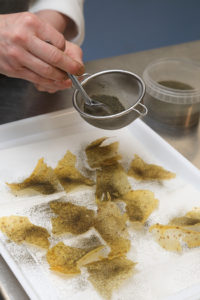
Dice 1kg of potatoes (skin on). Boil until soft. Blitz in a food processor, adding just enough of the cooking water to obtain a thin purée. Spread the purée, flecked with the skins, on dehydrator trays in as thin a layer as possible. Dry until crisp and then break into shards, ready for deep-frying. Deep-fry individual shards at 180°C for two to three seconds before service.
To assemble
- 1tbs pepper dulse powder
- 60-70g potato ice-cream
- 5ml cold-pressed hazelnut oil
- 10g Exmoor caviar
- Potato crisp shards
- Sprigs of pepper dulse
Sprinkle the pepper dulse over a chilled bowl. Form a quenelle of ice-cream with a tablespoon (4). Make a depression in the centre of the quenelle. Part-fill with oil (5). Spoon the caviar on top (6) and finish with potato crisp shards and sprigs of pepper dulse (7).
Grilled broccoli and seaweed
The precise ingredients of this salad will change with the seasons. Slokan, the purée base, is a reworked version of a Scottish recipe similar to Welsh laverbread.
Slokan (yields 500g, 25 portions)
- 500g dulse
- 200ml mushroom broth
- 2 heads [15-20 cloves] of black garlic, peeled
- 3 cloves fresh garlic
- Juice of 1 bergamot
To make the mushroom broth, vac-pack chopped chestnut mushrooms with 2% of their weight in salt (about 500g mushrooms to 10g salt). Poach for 45 minutes in a waterbath to extract their liquor. Strain.
Put the dulse and 200ml mushroom broth in a Thermomix. Poach and blend at 60°C, on medium speed for 45 minutes. Add black garlic, fresh garlic and bergamot (use lime juice if you can't find bergamot). Keep blending to obtain a smooth purée/paste. Pass through a fine chinois and add citrus juice to taste.
Smoked oil, mushroom broth and bergamot dressing
Combine 50ml mushroom broth with 50ml bergamot juice and 20ml smoked oil.
To assemble
Serves 1
- 30g purple or white sprouting broccoli
- 25g Slokan
- ½tsp pepper dulse powder
- 70ml smoked oil, mushroom broth and bergamot dressing
- 30g sprouted brassica tops and flowers
- Fennel sprigs, chervil and wild garlic leaves
- 2tbs mixed seasonal seaweeds (sea lettuce, truffle weed, tubular weed, pepper dulse, sea spaghetti)
- Ransom flowers
Chargrill the broccoli until it is tender but still crisp. Spoon the Slokan into the centre of the plate. Dust the pepper dulse powder around it on the plate.
Toss the broccoli, sprouted greens and fennel sprigs in the dressing. Add the seaweed so all the leaves are very lightly coated.
Build a 'ball' around the Slokan. Finish with brassica and ransom flowers.
Pam Brunton
Two years into a philosophy degree at the University of Edinburgh, Pam Brunton dropped out. A couple of bar jobs in the Highlands later, she switched from front of house to the kitchen. The change of tack, with one extended break, shaped her career. "I had a job where I could say with confidence: 'Yeah, I'm a chef'."
Along with long-time partner Rob Latimer, she owns Inver, a restaurant with four bothies for overnight accommodation 90 minutes' drive from Glasgow. It is isolated, overlooking a loch, and its success has hinged on her unique approach to cooking. Her style draws on spells in London at Tom Aiken's and the Greenhouse, at Noma and Fäviken in Scandinavia, at In De Wulf in Belgium and the Moulin de l'Abbaye in Périgord, France. As formative as her years in name-droppable kitchens is her continuing appetite for cookery books: "I read them cover to cover, like novels."
The food on her customers' plates speaks as much on farming and foraging suppliers and of the spirit of place as it does on her cooking know-how. She tries, she says, to create a virtuous circle where everyone in contact with Inver is at ease.
"In the early- to mid-2000s, there was a lot of the angry chef thing going on; there was shouting, bullying. Kitchens were very hierarchical. Obviously, I reacted against that. It wasn't the way I wanted to treat colleagues and suppliers."
Eight years into her career she asked herself whether "cooking rich food for rich people was all I wanted to do". She left the Greenhouse in Mayfair where she was working, enrolled at City, University of London to do an Msc in food policy and then worked first as a project manager for Sustain, the alliance for better food and farming, and then as the Soil Association's press officer - "I was arguing with the head of the NFU Scotland on Newsnight."
After five years away from professional kitchens, she returned to Scotland to set up Inver in 2015.
Brunton could claim a precedent for choosing an unlikely location. Nearly 40 years ago, the Norwegian Gunn Eriksen had opened Altnaharrie Inn on the shore of remote Loch Broom. She was the first female chef in the UK to earn two Michelin stars and the only woman to achieve this in Scotland to date. Her tasting menus were classically inspired, but her ingredients included foraged wild food, generations before Scandi-cooking came to prominence.
Brunton's kitchen is overtly green. Wherever possible she makes her own ingredients, be it crème fraîche or black garlic. She isn't, she agrees, seeking to join the luxury, fine-dining clan, but she does have a solid baggage of technical skills: "I want to achieve a certain level, but without having 12 guys working in the kitchen."



